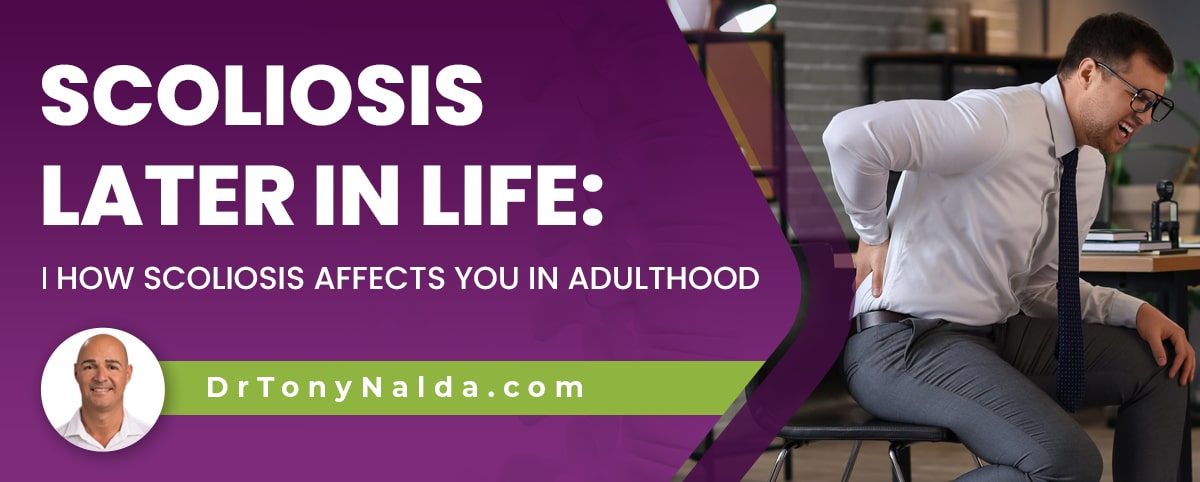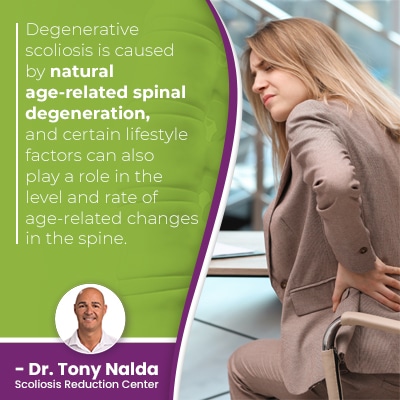Scoliosis Later in Life: How Scoliosis Affects You in Adulthood

Being diagnosed with scoliosis during adulthood and developing scoliosis later in life are two different things. Developing scoliosis as an older adult most often involves degenerative scoliosis, but the most common type of adult scoliosis is idiopathic, which actually develops during adolescence.
Scoliosis is most commonly diagnosed during adolescence, but it also affects adults. Adults are most commonly affected by idiopathic scoliosis, and older adults are most often diagnosed with degenerative scoliosis. Adult scoliosis can be painful.
Let's start by exploring the main differences between how scoliosis affects children and how it affects adults.
Table of Contents
Diagnosing Scoliosis
Diagnosing scoliosis means the spine has developed an unnatural curve; the spine will bend to the side unnaturally and rotate, making it a complex 3-dimensional spinal condition.
Being diagnosed with scoliosis means being diagnosed with a progressive condition; its nature is to get worse over time.
Scoliosis progressing means the size of the unnatural spinal curve is going to increase over time, as will the condition's uneven forces, and their effects.
While adolescent idiopathic scoliosis diagnosed between the ages of 10 and 18 is the most prevalent, the actual rate of scoliosis increases among the aging population, and this is due to natural-age related spinal degeneration.
Scoliosis is diagnosed through a physical examination and X-ray results, and the two main differences in condition effects between adults and children involve progression and pain.
Progression and Adult Scoliosis
As a progressive condition, counteracting its progressive nature is a focus of treatment.
In the majority of scoliosis cases, we don't know what causes them to develop, but we do know what makes them progress: growth.
Progression is triggered by growth spurts, which is why childhood scoliosis should always be taken seriously.
When treating childhood scoliosis, holding treatment results while the constant trigger of growth is occurring is the challenge, but when treating adult scoliosis, the trigger for rapid progression has been removed, but for older adults, spinal degeneration can increase the rate of progression as the spine becomes increasingly unbalanced and unstable.
Pain and Adult Scoliosis
For children, pain isn't a common part of living with scoliosis, and that's because the condition doesn't become compressive until adulthood has been reached, and that happens when skeletal maturity has been reached.
For patients who are still growing, the constant lengthening motion of growth counteracts the compressive force of the unnatural spinal curve, but for adults, it's compression of the spine and its surrounding muscles and nerves that causes the majority of condition-related pain.
Scoliosis pain can involve the muscles, the back, and pain that radiates into the extremities due to nerve compression.
Scoliosis pain can range from mild to moderate and severe; it can be mild and intermittent or chronic and debilitating.
In fact, the main symptom of scoliosis to bring adults in for a diagnosis and treatment is pain; the main symptom in children involves postural changes.
Now that we've touched on the main condition effects that differ between children and adults, let's talk about the differences in the two main condition types that affect adults: idiopathic scoliosis and degenerative scoliosis.
Idiopathic Scoliosis in Adults
Adolescent idiopathic scoliosis is the most prevalent condition type, but it's not always easy to detect.
There are never treatment guarantees, but with early detection and intervention, there are fewer limits to what treatment can achieve.
 Particularly when mild, scoliosis in children can be subtle, too subtle to notice, and as it's not commonly painful or associated with functional deficits, and the postural changes it causes can be subtle too.
Particularly when mild, scoliosis in children can be subtle, too subtle to notice, and as it's not commonly painful or associated with functional deficits, and the postural changes it causes can be subtle too.
In most cases, the earliest signs of scoliosis in children are uneven shoulders and hips as the condition's uneven forces disrupt the body's overall symmetry.
It's not unusual for adolescents to live with scoliosis unaware; in fact, idiopathic scoliosis in adults are cases of adolescent idiopathic scoliosis that weren't diagnosed or treated during adolescence, so they have progressed with time and maturity until becoming compressive and noticeable when growth stops.
The unfortunate reality is that had these patients received treatment during adolescence, their spines would be in far better shape than by the time they come to see me, but it's never too late to start treatment and work towards condition improvement.
The goal of treating idiopathic scoliosis in adults does include a curvature reduction, but as rapid progression due to growth isn't a concern, curvature reductions don't have to be as significant as in childhood scoliosis treatment; the goal is to reduce a curve back to where it was prior to becoming painful.
So idiopathic scoliosis, while the most common type to affect adults, doesn't actually develop during adulthood, but adolescence; it's degenerative scoliosis that develops fresh in adulthood.
Degenerative Scoliosis
After idiopathic scoliosis, degenerative scoliosis is the next most prevalent condition type to affect adults, and this is also referred to as de novo scoliosis because it develops fresh in adulthood with no prior history, unlike idiopathic scoliosis in adults.
Degenerative scoliosis affects older adults, commonly 50+, and is more common in females than males; this is due to the changes in bone density and hormones that are part of menopause.
Degenerative scoliosis is caused by natural age-related spinal degeneration, and certain lifestyle factors can also play a role in the level and rate of age-related changes in the spine.
Carrying excess weight, low activity levels, chronic poor posture, repeatedly lifting heavy objects incorrectly and straining the spine, and excessive consumption of alcohol and/or smoking can have the cumulative effect of awakening the spine and making it more vulnerable to degenerative changes.
When it comes to spinal degeneration, this most often starts with the spine's intervertebral discs that sit between adjacent vertebral bodies; in fact, degenerative disc disease is a contributing factor in the development of a number of spinal conditions/issues.
The discs perform many roles that are key to spinal health and function including providing cushioning between adjacent vertebrae, structure, flexibility, and acting as the spine's shock absorbers.
When a disc starts to degenerate, it can become desiccated and change shape, and this can affect the position of adjacent vertebrae attached and disrupt the ability of the vertebrae to stay aligned.
Treating Degenerative Scoliosis
The rate of progression can increase once spinal degeneration comes into play; while growth isn't occurring, the spine is weakened and vulnerable due to uneven forces.
As the spine degenerates, it will become increasingly unbalanced and unstable, and once scoliosis develops, this will only increase.
For treating degenerative scoliosis, this involves older patients, and the goal of treatment isn't as much about achieving a significant curvature reduction as much as preserving spinal function and increasing the spine's stability.
Improving Spinal Stability
 Through gentle and precise chiropractic adjustments, I can work towards realigning the spine as much as possible to improve its balance, and physical therapy and modified scoliosis-specific exercises can help with strengthening the spine's surrounding muscles so it's more supported and stabilized.
Through gentle and precise chiropractic adjustments, I can work towards realigning the spine as much as possible to improve its balance, and physical therapy and modified scoliosis-specific exercises can help with strengthening the spine's surrounding muscles so it's more supported and stabilized.
Pain management is also part of treating adult scoliosis, and this can involve pain medication, bracing for support, and proactive treatment that's addressing the underlying cause of scoliosis pain: the condition's structural nature.
If improvements are made to the spine's alignment and the spine's surrounding muscle strength is improved, the spine is more balanced and stable, and there will be less movement within the spine, and this will improve pain as the spine's stability is improved.
So developing scoliosis later in life can happen, and when it does, the focus of treatment is about condition improvement for the best quality of life, and this means making the spine more balanced and stable.
Conclusion
Those who develop scoliosis later in life are facing degenerative scoliosis caused by natural age-related spinal degeneration and the cumulative effect of certain lifestyle factors.
Developing scoliosis later in life means that spinal degeneration is a factor, and this involves the intervertebral discs degenerating and disrupting the spine's strength, flexibility, structure, and its ability to handle mechanical stress.
While there are different types of scoliosis, adults are most commonly affected by idiopathic scoliosis and degenerative scoliosis.
Here at the Scoliosis Reduction Center®, I've treated patients of all ages, including older adults, and the most important thing to understand about scoliosis is that as a progressive condition, the best time to start treatment is always now.
Scoliosis gets more complex to treat the more it progresses, as the spine becomes increasingly rigid and less responsive to treatment, hence the benefit of being proactive and starting treatment as close to the time of diagnosis as possible.
Here at the Center, I've helped a number of older patients improve their spinal health and quality of life as a result.
Dr. Tony Nalda
DOCTOR OF CHIROPRACTIC
After receiving an undergraduate degree in psychology and his Doctorate of Chiropractic from Life University, Dr. Nalda settled in Celebration, Florida and proceeded to build one of Central Florida’s most successful chiropractic clinics.
His experience with patients suffering from scoliosis, and the confusion and frustration they faced, led him to seek a specialty in scoliosis care. In 2006 he completed his Intensive Care Certification from CLEAR Institute, a leading scoliosis educational and certification center.
About Dr. Tony Nalda
 Ready to explore scoliosis treatment? Contact Us Now
Ready to explore scoliosis treatment? Contact Us Now





